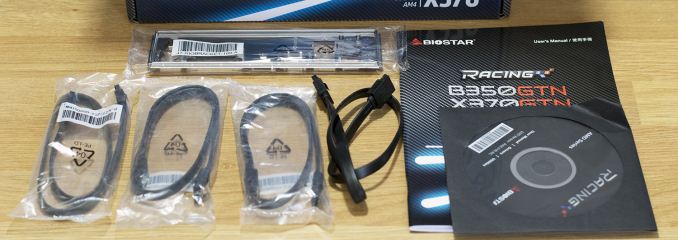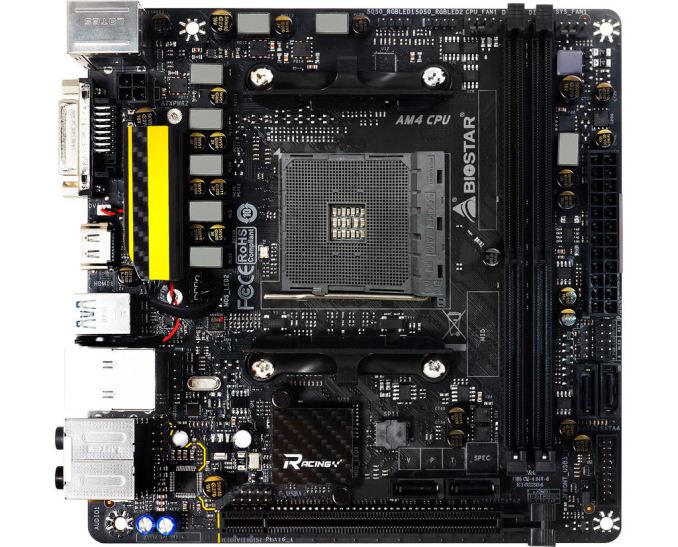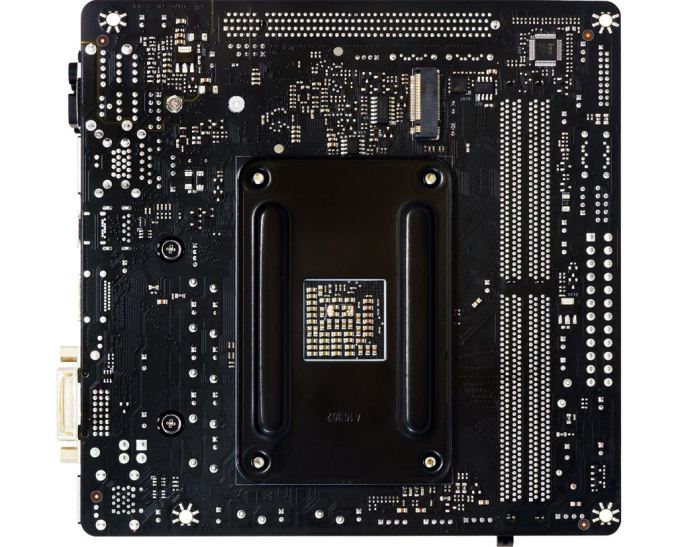The Biostar X370GTN Mini-ITX Motherboard Review: AM4 Goes Tiny
by Gavin Bonshor on October 23, 2017 9:00 AM ESTBoard Features
Biostar wasn’t just the first manufacturer to release and produce an ITX motherboard for the AM4 platform, but the X370GTN is one of the cheapest X370 boards on the market. One of the benefits that some vendors are exploiting is that users can build a small and affordable system with 8-core processors with Ryzen, although few are reluctant to go into the mini-ITX form factor.
| Biostar X370GTN Mini ITX Motherboard | |
| Warranty Period | 3 Years |
| Product Page | Link |
| Price | $110 |
| Size | Mini-ITX |
| CPU Interface | AM4 |
| Chipset | AMD X370 |
| Memory Slots (DDR4) | Two DDR4 Supporting 32GB Dual Channel Up to 3200 MHz |
| Video Outputs | HDMI 1.4 DVI-D |
| Network Connectivity | Realtek RTL8118AS |
| Onboard Audio | Realtek ALC892 |
| PCIe Slots for Graphics (from CPU) | 1 x PCIe 3.0 (x16) |
| PCIe Slots for Other (from PCH) | None |
| Onboard SATA | Four, RAID 0/1/10 |
| Onboard M.2 | 1 x PCIe 3.0 x4, on Rear |
| USB 3.1 (10 Gbps) | 1 x Type-C 1 x Type-A |
| USB 3.0 (5 Gbps) | 4 x Rear Panel 1 x Header |
| USB 2.0 | 2 × via header |
| Power Connectors | 1 x 24-pin ATX 1 x 4-pin CPU |
| Fan Headers | 1 x CPU (4-pin) 1 x System (4-pin) |
| IO Panel | 4 x USB 3.1 (USB 3.1 Gen 1) 1 x USB 3.1 (USB 3.1 Gen 2) 1 x USB 3.1 Type-C 1 x Network RJ-45 1 x DVI-D 1 x HDMI 1.4 1 x Combo PS/2 5 x 3.5 mm Audio Jacks 1 x Optical SPDIF Out Port |
The size of the motherboard means that there is only two memory slots, although Biostar lists these as supporting up to DDR4-4000. Although RGB does not enhance performance, it is a popular feature (especially for marketing), and the X370GTN has an RGB header that is controllable through software as well as some embedded LEDs on one of the heatsinks.
In The Box
We get the following:
- Four black SATA cables
- User manual
- Driver installation disk
- I/O shield
Inside the box, we have the minimum number of accessories which you would expect to find with any motherboard. This includes four black straight SATA cables, one for every SATA port. If Biostar were going to plug the 'gaming' aspect of the package, we might have expected something a little extra here, however, the cost is also a factor.
Visual Inspection
The X370GTN features a fairly basic layout, with an all-black PCB and a pair of small racing styled heat sinks, one covering the power delivery and one on the chipset. The power delivery heatsink is small and contains a wave of RGB LED lights integrated into it. While this heatsink manages to cover what is intended, the size seems relatively inadequate and it doesn’t have much mass to it. The chipset heatsink is also light, to which Biostar are using push pins for mounding and equipped it with a subtle carbon effect wrapper to enhance the look.
There are only two fan headers on the board, found either side of the two memory slots. This used to be normal for mini-ITX motherboards, although recently the main manufacturers have started supporting three as a standard. Looking to processor power connectivity, only a single 4pin 12V power connector is required to power the board. This is more than capable of running any Ryzen CPU at stock, but might not be sufficient for large overclocks.
A noticeable feature on the Biostar board is the use of 5k rated solid state polymer capacitors, which is a little disappointing. Most AM4 motherboards usually have 10k or 12k rated caps, which corresponds to their longevity. These caps are unmarked/unbranded, so it is unclear where Biostar is sourcing them from. At the bottom end of the motherboard, Biostar has equipped four SATA ports, with two of them running parallel above the single PCIe x16 slot, and the other two next to the memory slots. Also in this area are a pair of USB front panel headers, with one for USB 3.0 (5 Gbps) and the other for USB 2.0.
The board has a 4+3 phase power delivery design, which is typical given the size of the board and price point. The X370GTN features seven ER30 1712 Ferrite chokes, seven NIKO Semiconductor MOSFETs and is controlled by the Intersil ISL95712. The 4+3 phase is split into two separate sections with four being dedicated to the CPU, with the other three likely in place for upcoming APUs (Ryzen with bundled graphics).
On the rear panel, we find a four USB 3.0 (5 Gbps) ports, and two USB 3.1 (10 Gbps) ports, with the latter having a Type-C and Type-A. The Realtek Dragon networking chip provides the gigabit networking port, while the Realtek ALC892 provides the audio jacks. A PS/2 combo port is also present, and video outputs are a single DVI-D connector, supporting resolutions of up to 1920 x 1200 @ 60Hz, and a sole HDMI 1.4 output supporting 3840 x 2160 @ 30Hz. These video outputs are for users who are investing in the current Bristol Ridge APUs, or looking to potential future APUs supported on the platform.
Even though the rear PCB of the Biostar X370GTN is mostly covered up by the AMD cooler installation backplate, Biostar has included a single PCIe 3.0 x4 M.2 port to the rear. When using the M.2 port in PCIe mode, Ryzen processors will offer a maximum bandwidth rate of up to PCIe 3.0 x4, while Bristol Ridge APUs allow for up to a maximum of PCIe 3.0 x2. Both 2260 and 2280 sized options featuring M key type connectors are supported by this board.















31 Comments
View All Comments
Brother Ali - Thursday, October 26, 2017 - link
I have the asrock itx B350 and a 1600. I have my voltage set to 1.375 in the bios. In HWMonitor its .384V-1.392V; stays at 1.392V consistently.austinsguitar - Wednesday, October 25, 2017 - link
this sort of thing is why itx is bad for high wattage components. you cant expect much from this gigabyte board. the cooling on the vrm is awful. horindusly bad. these motherboards should not be overclocked too high for the long run. if you look up guides on the design of them they all miss the mark in components and cooling. so all in all. mini itx, dont do it on ryzen. atleast for overclocking long term. your problem is not new.xrror - Wednesday, October 25, 2017 - link
This is a Biostar board, not Gigabyte.Dr. Swag - Monday, October 23, 2017 - link
It would be great to see a better look into the vrms (efficiency, mosfet temps, etc.). AM4 VRMs seem to have been a hot topic (pun intended) since Ryzen launched due to boards with pretty budget vrms being able to run with 8 core CPUs. I would like a more in depth look into the vrms of each board to see how worthy all of them are.u.of.ipod - Monday, October 23, 2017 - link
Always happy to see small form factor reviews!!!Lurpak - Monday, October 23, 2017 - link
I have had this motherboard for since June and to be honest, I can not recommend it. If you are running an old version of the BIOS the motherboard is so unstable that it crashes all the time. My first unit died on me during a BIOS update (there's no backup BIOS), but luckily I was able to update the BIOS on the second one.Currently my problems are with memory where the motherboard sometimes fail to boot at XMP settings, which then requires me to set them again and hope that it works. My memory problems could be down to AGESA and seems to have been more stable since I got a BIOS update with AGESA 1.0.0.6b, but it still fails once in a while.
twnznz - Tuesday, October 24, 2017 - link
Does yours power cycle 5x when it fails a boot as well? I'm rolling AGESA 1.0.0.6b as well, Trident Z F4-3200C14D-16GTZR 14-14-14-34, with XMP settings. I've wound the mem voltage up to meet 1.35vLurpak - Tuesday, October 24, 2017 - link
Yeah, that is exactly what it does. The 5 times power cycle is a fail-safe designed to catch errors in BIOS settings. From what I have read the problem with the board seems to be, that it cannot get the correct voltage for the RAM and therefore fails boot. I am running G.Skill Ripjaws V, which runs at higher latencies.Paull29724 - Sunday, November 19, 2017 - link
I just got this motherboard, whats your system config?jrs77 - Monday, October 23, 2017 - link
mITX-boards are allways nice, but without an APU a mITX-board is pretty much useless for the majority of people, who would want to build a silent and powerefficient HTPC or SFF-office station with these.